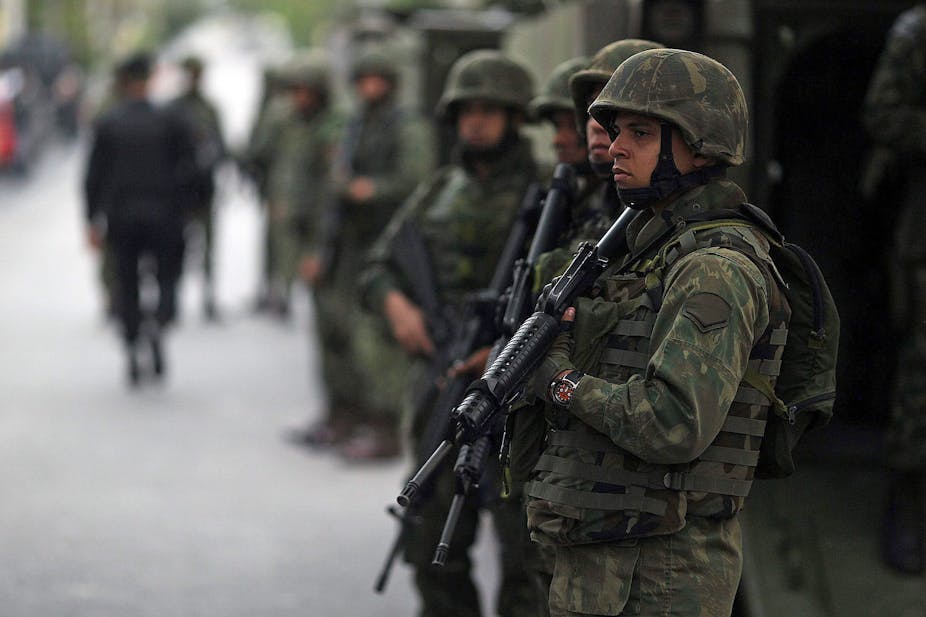Brazil is famous for many things: samba, football and beaches, but also its favelas, the poor neighbourhoods that encircle its cities. These areas are often on invaded lands in middle and upper-class neighbourhoods. The biggest, such as Nordeste de Amaralina in Salvador and Rocinha in Rio de Janeiro, have over 100,000 residents, closely packed into houses that have been extended upwards by adding extra storeys.
These favelas are one of Brazil’s most visible characteristics, making the divides between rich and poor plain to see. The people living in the favelas are generally disaffected over the irregular land tenure, but some are also involved in heavily armed drug-trafficking gangs.
It is unknown how many favelas exist. Brazil’s 2000 Census counted 513 favelas in Rio, but there are estimated to be at least 1000 now with over two million residents. As the football World Cup rapidly approaches, capturing global audiences and huge amounts of capital for FIFA and corporate sponsors, the blame these areas attract for the crime and violence of Brazil has increased.
In preparing for the World Cup, the Brazilian government has evicted residents from their homes for commercial development and increasing real estate values. But the government has denied forcibly evicting families from their homes without due process, or for the sole purpose of infrastructure projects related to the World Cup and the 2016 Olympics.
In a recent book, American sports journalist Dave Zirin characterises these huge events as “Trojan horses” for neoliberal assaults on the general population, in a similar manner to Naomi Klein’s “shock doctrine”. Extraordinary events are used to create a “state of exception”, allowing the capitalist elite – through the state – to impose drastic economic and social alterations.
Instead of “disaster capitalism”, sports events become “celebration capitalism”, where strong corporate pushes can be hidden under the supposed joy of bringing the world together in sport.
World Cups and Olympics have displayed this pattern clearly in past decades. Host nations have been witness to large-scale evictions and social cleansing in which the poor are removed from sight. This aids in the gentrification and corporatisation of public space, the erosion of civil liberties and huge increases in surveillance.
Huge subsidies flow to private hands. The construction, real estate, security and media industries enjoy a boom at the expense of the poorer communities left behind. In most cases, this all has the celebratory consent of the population.
In Brazil, police began the “pacification” in 2008, attacking gangs in the slums and setting up permanent posts. So far, at least 37 such “police pacification units” have been created, covering an area with a population of 1.5 million people.
As a result of this state violence, the number of people who have “disappeared” in Rio has increased to more than 4000. Amnesty International has taken a dim view of the government’s plans:
The government is trying to paint a pretty picture for the world, saying things have been cleaned up and that Brazil is safe for tourists. But the reality is far darker.
This is not a new phenomenon. Police violence has been endemic in Brazil; it represents the long history of economic racism, social oppression, stigmatisation and criminalisation of the majority “barbarous” poor. The local police have officially admitted that they committed some 5000 murders in a 2007 report. But as one Brazilian politician said:
Jails are for convicted bandits, not for cops.
The oppression has continued with laws to silence protests against the World Cup. The tournament is a new round of capitalist accumulation, in combination with the eviction of peoples to turn their land into profit.
But the resistance has also risen. Protests have cropped up throughout Rio, largely against police violence as well as forced removals for the World Cup.
The most visible resistance was protests in Copacabana in April after the death of Douglas Rafael da Silva, or DG, a dancer who appeared on a popular TV show. Pacification police allegedly murdered Da Silva in the Pavão-Pavãozinho favela. These protests resulted in one death and sparked fear in a traditionally middle-class neighbourhood, with streets shut down and fires burning.
Residents in the Cantagalo favela, near the affluent suburb of Ipanema in Rio, lit fires in the streets and protested the shootings of two residents in April. This was followed by a protest in Alemão after a fatal shooting of an elderly woman, with a bus set alight and rocks thrown.
Additionally, multiple buses were set on fire in Pavuna after the death of a young resident in the Chapadão favela.
Perhaps pacification, despite its many problems, may actually be giving favela residents a louder voice. There is a greater opportunity to reveal state abuses in an often-forgotten part of the world with the spotlight currently on Brazil.
However, those disgusted by the evictions, police brutality and destruction of communities may all miss this in the intoxicating energy of the World Cup and the mythical “Carmen Miranda” view of Brazil, making this form of celebratory capitalism the real winner in sports.

